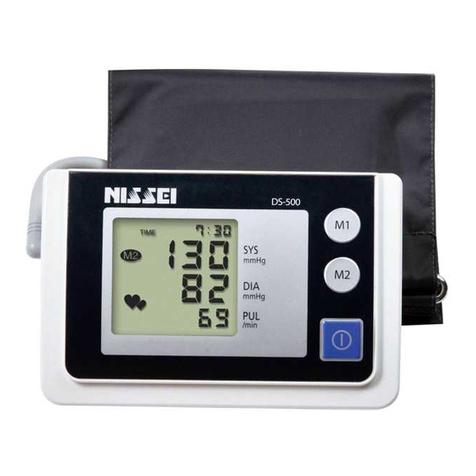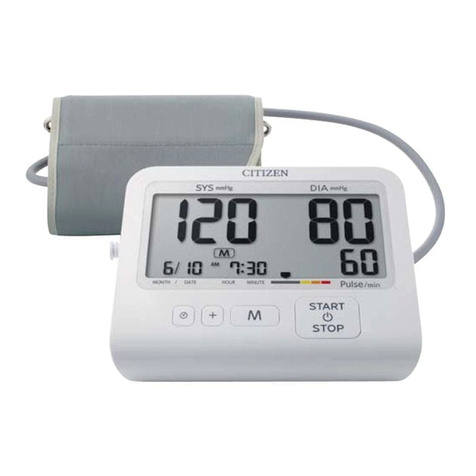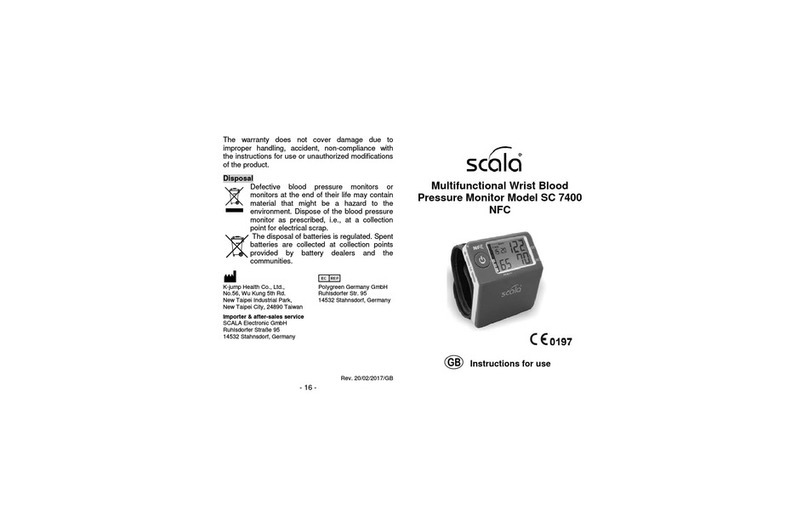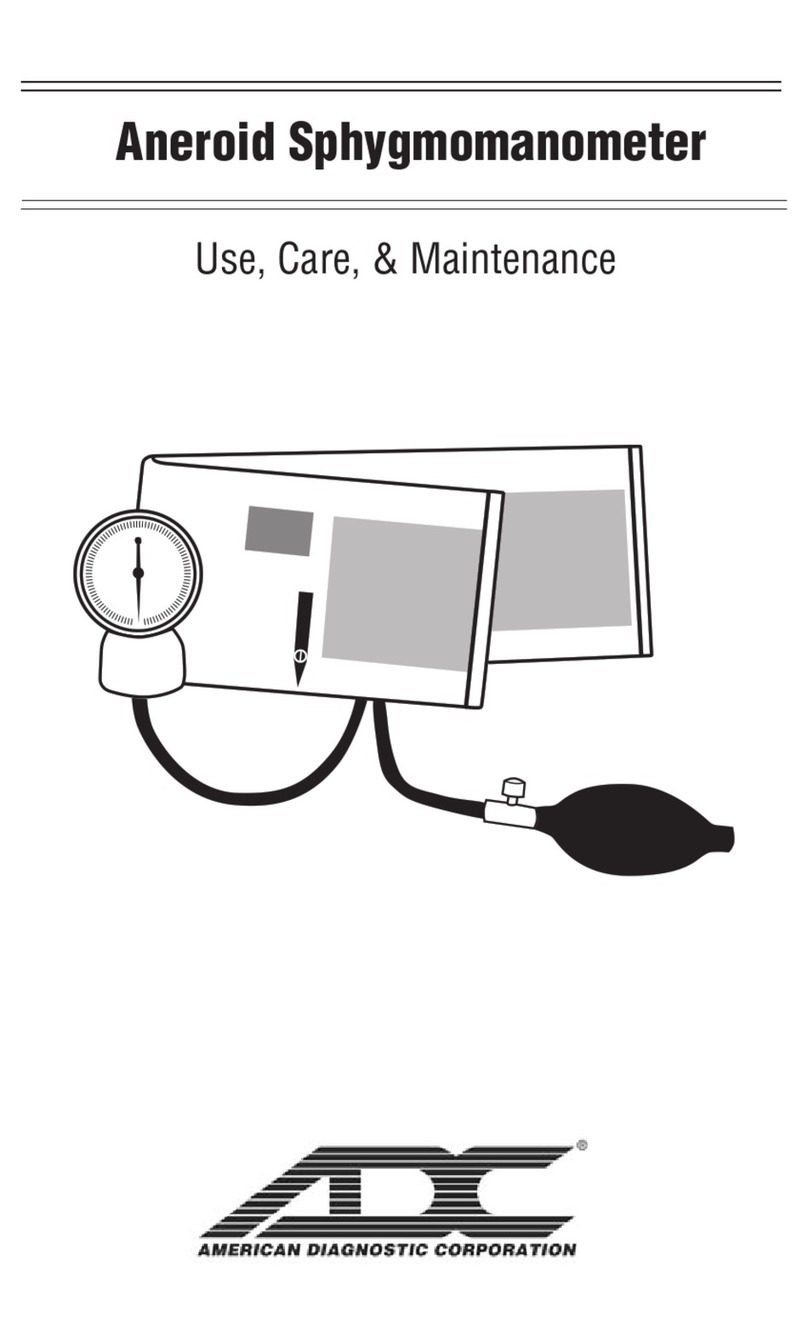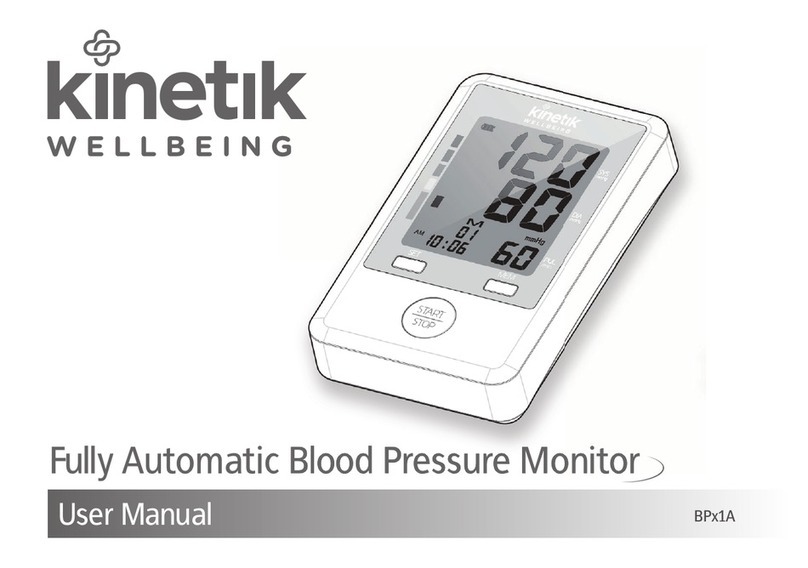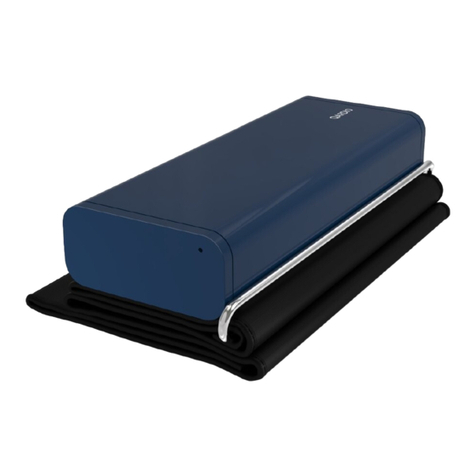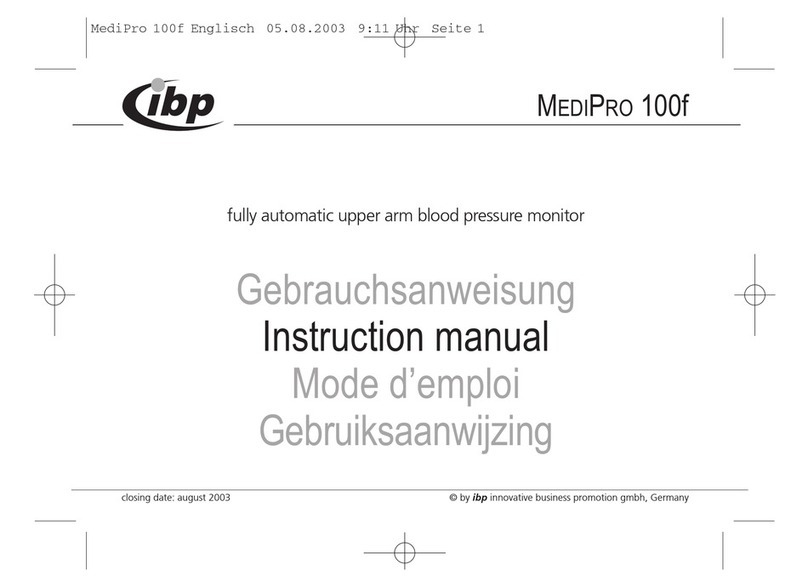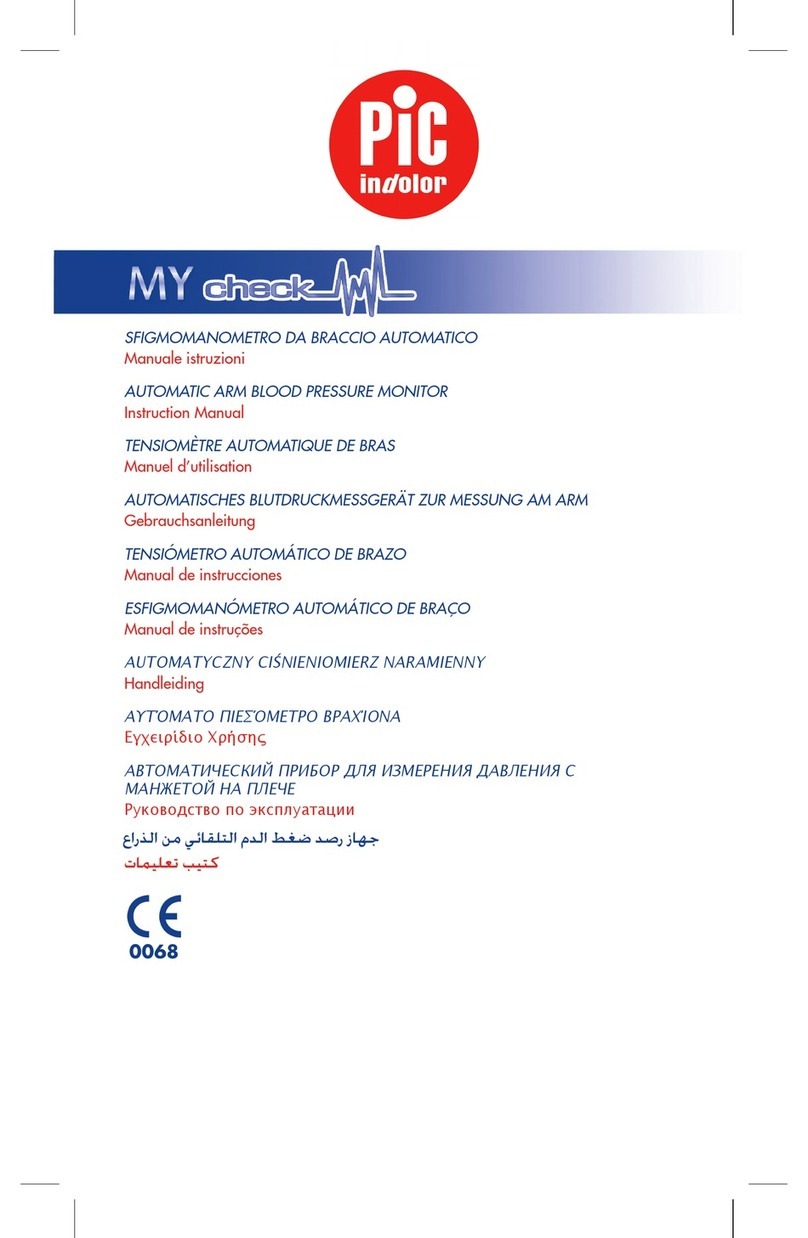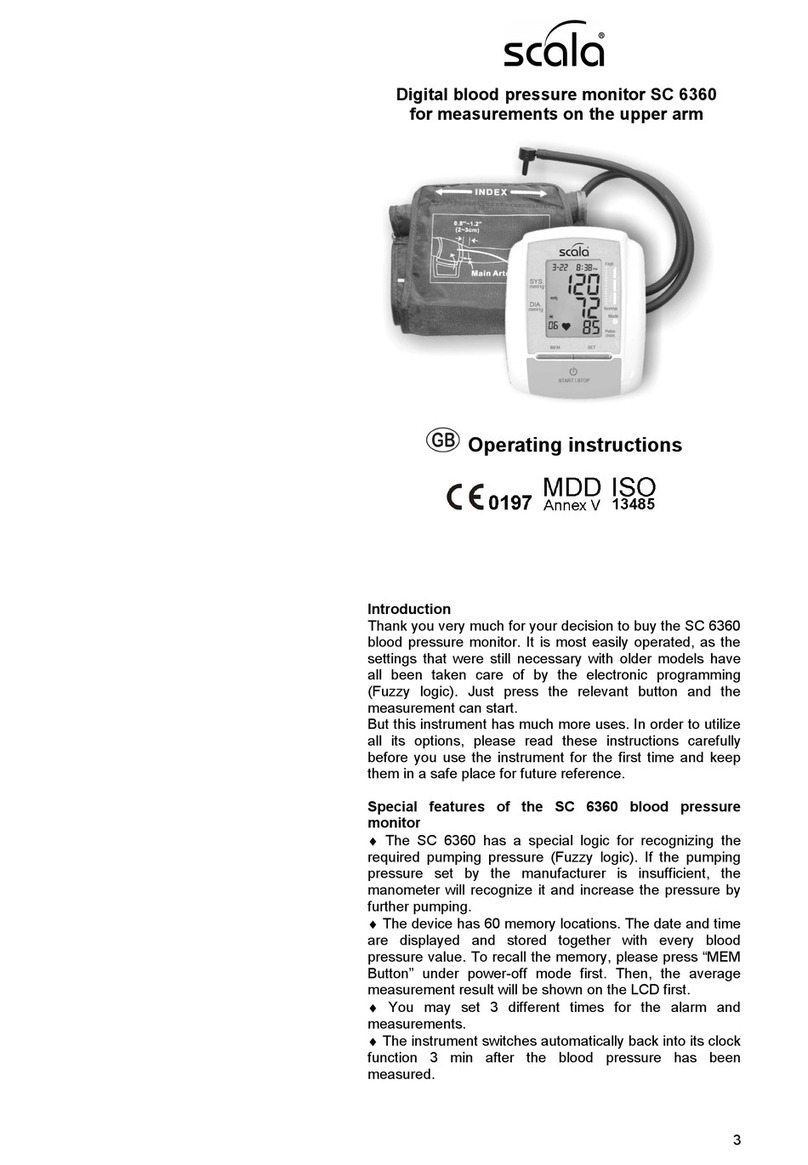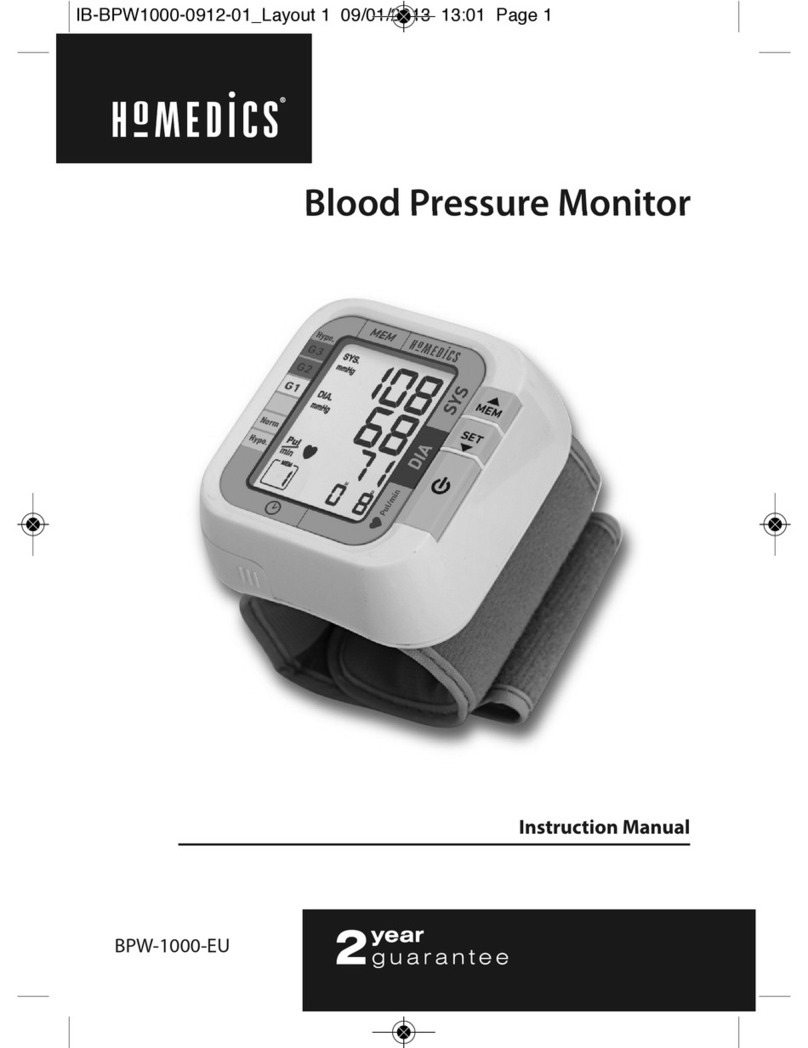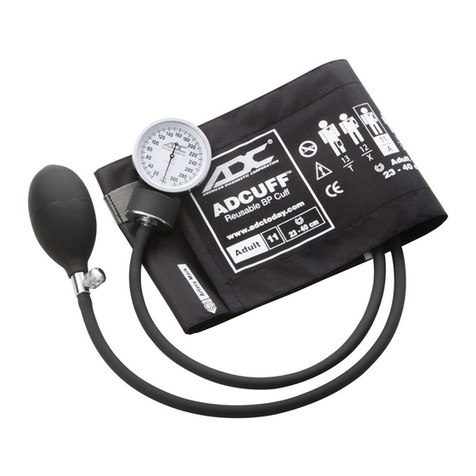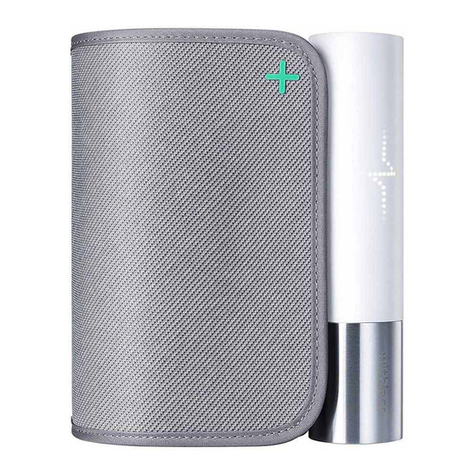Nissei DSK-1011 User manual

INSTRUCTIONS
This manual is intended to assist you in the safe and efficient operation of BLOOD PRESSURE MONITOR DSK-1011. The product must be used in accordance with the procedures contained in this
manual and must not be used for purposes other than those described herein. It is important to read and understand the entire manual. In particular, please read carefully and become familiar with the
section entitled “TIPS ON TAKING YOUR BLOOD PRESSURE”.
BEDIENUNGSANLEITUNG
Dieses Handbuch soll den Anwender bei der sicheren und wirkungsvollen Blutdruckmonitors DSK-1011 unterstützen. Das Produkt ist in Übereinstimmung mit den in diesem Handbuch enthaltenen
Verfahren zu verwenden und darf nicht für irgendwelche, in diesem Handbuch nicht beschriebenen Zwecke verwendet werden. Lesen Sie bitte vor allem das Kapitel “TIPPS ZUR
BLUTDRUCKMESSUNG” aufmerksam durch und machen Sie sich damit vertraut.
INSTRUCTIONS
Ce guide est destiné à favoriser l'utilisation sûre et efficace de Moniteur de tension artérielle DSK-1011. Le produit doit être utilisé conformément aux procédures contenues dans le présent guide et ne
doit pas être utilisé à d'autres fins que celles décrites ici. Il est important de lire et de comprendre le guide dans sa totalité. En particulier, veuillez lire attentivement et vous familiariser avec la section
intitulée “CONSEILS POUR MESURER VOTRE TENSIONARTÉRIELLE”.
ISTRUZIONI
Questo manuale assiste l'utilizzatore nell'uso efficiente e sicuro dello Sfigmomanometro DSK-1011. Usare il prodotto seguendo le procedure specificate nel presente manuale. Il prodotto non deve
essere usato per scopi diversi da quelli indicati. Si raccomanda di leggere attentamente tutto il manuale. In particolare, si raccomanda di leggere e seguire attentamente le informazioni riportate nella
sezione “CONSIGLI SULLAMISURAZIONE DELLA PRESSIONE SANGUIGNA”.
ΟΔΗΓΙΕΣ
Το εγχειρίδιο αυτό προορίζεται για να βοηθήσει το χρήστη στην ασφαλή και αποτελεσματική λειτουργία του Ψηφιακού Μετρητή Αρτηριακής Πίεσης DSK-1011. Το προϊόν πρέπει να χρησιμοποιείται
σύμφωνα με τις διαδικασίες που περιλαμβάνονται στο παρόν εγχειρίδιο και δεν πρέπει να χρησιμοποιείται για σκοπούς διαφορετικούς από εκείνους που περιγράφονται στο παρόν. Είναι σημαντικό
να διαβάσετε και να κατανοήσετε το εγχειρίδιο εξ ολοκλήρου. Ειδικότερα, διαβάστε προσεκτικά και εξοικειωθείτε με την ενότητα “ΣΥΜΒΟΥΛΕΣ ΓΙΑ ΤΗ ΜΕΤΡΗΣΗ ΤΗΣ ΑΡΤΗΡΙΑΚΗΣ ΣΑΣ ΠΙΕΣΗΣ”.
INSTRUKCJA OBSŁUGI
Niniejsza instrukcja użytkowania ma na celu pomóc użytkownikowi w bezpiecznym i sprawnym korzystaniu z elektronicznego ciśnieniomierza krwi DSK-1011. Aparat winien być używany zgodnie z
zaleceniami niniejszej instrukcji i nie może być wykorzystywany do innych celów niż wymienione poniżej. Istotne jest, aby użytkownik przeczytał dokładnie i zrozumiał niniejszą instrukcję. W
szczególności prosimy o uważne zapoznanie się z działem zatytułowanym “UWAGI DOTYCZĄCE POMIARÓW CIŚNIENIA”.
BLOOD PRESSURE MONITOR
GB
DE
FR
IT
GR
PL

-2-
PART NAMES AND PRODUCT COMPONENTS . . . . . . . . 2
GENERAL INFORMATION . . . . . . . . . . . . . . . . . . . 2
PRECAUTIONS AND CONTRAINDICATIONS . . . . . . . 5
TIPS ON TAKING YOUR BLOOD PRESSURE . . . . . . . 6
PREPARATIONS BEFORE USE . . . . . . . . . . . . . . . 6
MAKING A MEASUREMENT . . . . . . . . . . . . . . . . . 8
VIEWING THE SAVED READINGS (MEMORY FUNCTION)
. . . . . . . . . . . . . . . . . . . . . . . . . . . . . . . . . . . . 10
TROUBLESHOOTING . . . . . . . . . . . . . . . . . . . . . 11
TECHNICAL DESCRIPTION . . . . . . . . . . . . . . . . . 13
WARRANTY . . . . . . . . . . . . . . . . . . . . . . . . . . . 80
PART NAMES AND PRODUCT COMPONENTS
CONTENTS
GENERAL INFORMATION
For test use
AIR PLUG
AIR CONNECTOR
DISPLAY
“START/STOP” KEY
MEMORY KEY [2]
MEMORY KEY [1]“SET” KEY
BATTERY
COMPARTMENT
AC CONNECTOR
MAIN UNIT CUFF
AA (LR6) BATTERIES
INSTRUCTIONS
AIR HOSE
AC adaptor not included
INDICATIONS FOR USE
This product is intended for noninvasive measurement of systolic and diastolic blood
pressure, determination of pulse rate and calculation of pulse pressure in adults in a home
healthcare environment. The product is not designed for neonatal use. Please consult with
your doctor or physician to use this product to take blood pressure of child or person in
pregnancy or under pre-eclamptic condition.
METHOD OF MEASUREMENT
This product employs the oscillometric method for measurement of blood pressure and
pulse rate. The cuff is connected to the main unit and wrapped around the arm. Circuits
within the cuff sense the small oscillations in pressure against the cuff produced by the
expansion and contraction of the arteries in the arm in response to each heart beat. The
amplitude of each pressure waves is measured, converted to millimeters of mercury, and

-3-
PRESSURE
TIME
displayed on the LCD as a digital value.
MEASUREMENT ON INFLATION
Initially the cuff is rapidly inflated to the prescribed value
at the beginning of a measurement, during which the
inflation mark is displayed. After the pressure reaches
this point, the inflation mark disappears and the cuff is
inflated more gradually, during which pulse wave is
detected. As pulse wave is detected, heart mark flashes
with synchronizing beep. Measurement ends when
systolic blood pressure is determined and air is
exhausted from the cuff.
PERSONAL MODE
The inflation is adjusted based on the latest three
readings in the selected bank, either [1] or [2], to shorten
the measurement time and to improve comfort.
For example, high diastolic blood pressure values from
past three measurements will lead to inflation to higher
pressure value than the default value. In the event that
this value is too high for your current blood pressure,
the cuff will rapidly deflate and measurement will
restart.
To use the personal mode effectively, chose the memory bank before starting a
measurement. This monitor remembers the last memory bank that was displayed. To
choose the memory bank before starting a measurement, display a reading saved in the
desired memory bank, turn off the monitor once and then start measurement.
WHO CLASSIFICATION SYMBOL
Measured blood pressure values are classified against WHO guideline (1999).
The higher class applies when systolic and diastolic pressures fall into different classes.
For specific information on your blood pressure, contact your physician. Never make any
judgment on your own based on the classification indication only.
SYS (mmHg)
>180
160-179
140-159
130-139
120-129
<120
DIA(mmHg)
>110
100-109
90-99
85-89
80-84
<80
WHO CLASSIFICATION
Hypertension (severe)
Hypertension (moderate)
Hypertension (mild)
High Normal
Normal
Optimal
DISPLAY
PULSE PRESSURE DISPLAY
This product calculates and displays pulse pressure.
While systolic blood pressure keeps increasing with age, diastolic blood pressure tends to
start decreasing at around age 50. Pulse pressure is value subtracting diastolic value from
systolic value and therefore pulse pressure tends to increase with age. Pulse pressure has
been considered to be related to stiffness of artery and has been studied as one of
circulatory risk factors. It is sometimes said that 45 mmHg of pulse pressure is normal
value. Pulse pressure only does not represent arterial sclerosis. However, observation of
pulse pressure in long term will be important.
BODY MOTION SYMBOL
Blood pressure value taken while moving cannot be said to be the correct value because
body movement can affect blood pressure.
PRESSURE
TIME
RAPID
INFLATION
GRADUAL
INFLATION
RAPID
EXHAUST
INITIALPRESSURE
CHANGE
WHO: World Health Organization
AN EXAMPLE OF PRESSURE
CHANGE DETERMINED WITH
"PERSONALMODE"

-4-
regular pulse rhythm
An example of irregular pulse rhythm
compared to regular pulse rhythm
This product analyzes pulse wave and displays [
] when body motion is detected.
[
] indicates the results might be affected by body movement.
IRREGULAR PULSE RHYTHM SYMBOL
Pulse rhythm can be disturbed from talking,
moving or arrhythmias. This product
displays [
] when the difference of
shortest and longest time intervals between
pulse waves is over 25%, indicating
irregular pulse rhythm.
MEMORY FUNCTION
The measured values are automatically saved for later review in either one of two memory
banks, [1] or [2]. These two memory banks can be used to save readings of two persons
separately or to save morning readings and evening readings separately.
Each bank can save up to 60 readings. When the number of stored readings reaches 60,
the oldest reading will be deleted to record new reading.
Saved readings are recalled with measurement date and time when clock function is
activated. *The clock needs to be activated before measurement for date and time to be
saved with the measured valued.
[Err] results are not saved.
CARE AND MAINTENANCE
Keep the product clean. Inspect its cleanliness after use. To clean, use only a soft dry
cloth. Do not use gasoline, paint thinner, or other strong solvents. Since the cuff may
absorb perspiration and other fluids, inspect it for stain and discoloration after each use.
When cleaning the cuff, use a synthetic detergent and gently rub the surface. Air dry
thoroughly. Make sure fluid never gets in AIR HOSE. Do not machine wash or scrub it.
When storing the product, do not place heavy objects on it. Do not fold or bend the cuff
forcibly. To disconnect the cuff from the main unit, do not pull AIR HOSE but hold AIR
PLUG and unplug it. Do not coil AIR HOSE too tightly. When the product has been stored
at a temperature below the freezing point, keep it for at least 1 hour in a warm place before
using. Remove the batteries if the product is to be stored for an extended period of time.
Keep the batteries out of reach of children.
We suggest that you have your blood pressure monitor checked every 2 years. This operation
may only be performed by the manufacturer or by firms authorized by the manufacturer.
PRODUCT SPECIFICATIONS
Model : DSK-1011
Operating Principle : Oscillometric method
Indicator : 15 digits liquid crystal display
Pressure Indicating Range : 3 to 300 mmHg (cuff pressure)
Measuring Range : 50 to 250 mmHg (systolic), 40 to 180 mmHg (diastolic), 40
to 160 bpm (pulse rate)
Accuracy* : ±3 mmHg (cuff pressure), ±5% of reading (pulse rate)
Inflation : Automatic inflation
Exhaust : Automatic exhaust valve
PowerSupply : Four 1.5 volt LR6 (AA alkaline) batteries or AC adaptor
ADP-W5 series
Power Consumption : 4W (max.)
Electric Rating : DC6V/4W, with four LR6 batteries
Adaptor;AC100-240V, 50-60Hz, 0.12A,
Unit; DC6V, 500mA, with designatedAC adaptor
Memory : 2 banks, each stores 60 readings
Operating Condition : +10˚C to +40˚C, 15% to 85% RH (noncondensing)
Transportation/Storage Condition
: -20˚C to +60˚C, 10% to 95% RH (noncondensing)
Cuff : Coverage arm circumference; 22 to 32 cm, applied part; BF
Main Unit : Weight;Approx. 250 g (without batteries)
Size; Approx. 115 x 115 x 65.9 mm (W x D x H)
Protection class IP : IP 20: Protected against solid foreign particles with a
diameter of more than 12.5 mm, no protection against water.

-5-
PRECAUTIONS AND CONTRAINDICATIONS
Protection against electric shock
: Internally powered equipment/Class II equipment, Type BF
applied part
Mode of operation : Continuous operation
Classification : Internally powered equipment/Class II
Key to symbols : Type BF applied part
: Class II equipment
: Refer to instruction manual/booklet.
: Keep dry
: The used electrical and electronic products are not household
Do not use this product without consultation with your doctor if you are under
dialysis therapy or on anticoagulants, antiplatelets or steroids. Use of this
instrument under such conditions could cause internal bleeding.
For specific information on your blood pressure, contact your physician. Never
make any judgment on your own regarding measurement results.
Do not use this product along with implantable and wearable medical electrical
equipment such as pacemaker, defibrillator, or electrocardiographic monitor.
This product is not also intended to be used with HF surgical equipment.
Do not use this product in an explosive environment such as near flammable
anesthetics or inside oxygen chamber.
The system may fail to yield specified measurement accuracy if operated or
stored in temperature or humidity conditions outside the limits stated in the
specifications section of this manual.
Do not use cuffs or accessories other than those specified by the
manufacturer. Otherwise, correct measurement readings cannot be obtained.
Use of this product in areas near mobile phones, microwave ovens or other
devices with strong electromagnetic field may cause malfunctions.
Do not apply the cuff over wounded arm, arm under an intravascular access or
therapy or an arterio-venous shunt, or arm on the side of a mastectomy.
Otherwise injury may be resulted.
Make sure that inflation of the cuff is not causing prolonged impairment of
blood circulation. Also, be cautious about temporary loss of the functions of
any other medical equipment if any monitoring equipment is used on the same
limb with the blood pressure measuring cuff.
To avoid harmful injury due to interfered blood flow from cuff inflation,
- Make sure that AIR HOSE is not kinking before measurement. Otherwise,
cuff inflation may not be conducted properly and prolonged, and
- Do not make measurements repeatedly.
To avoid any possibility of accidental strangulation, keep this product away
from children and do not drape AIR HOSE around your neck.
Because the product includes precision parts, avoid extreme temperature
variations, humidity, shock, dust, and direct sunlight. Do not drop or strike the
waste. Follow your national/local recycling rules to dispose of
them properly. In the EU countries, please refer to waste
management symbol(s) marked on the package or the
instrument.
This device complies with EN1060-1:1995+A2:2009 Non-invasive sphygmomanometers
Part 1: General requirements, EN1060-3:1997+A2:2009 Non-invasive shygmomanometers
Part 3: Supplementary requirements for electro-mechanical blood pressure measuring
system and EMC (IEC60601-1-2:2007).
*Accuracy is guaranteed with the measured values that are within the measuring range.
Specifications are subject to change without notice due to improvements in performance.

-6-
PREPARATION BEFORE USE
TIPS ON TAKING YOUR BLOOD PRESSURE
product. Make sure not to expose it to moisture. This product is not water resistant.
Do not press the display and operation keys or place the monitor with display
face down.
Do not take out batteries or unplug the AC adaptor when the monitor is turned
on. Make sure to switch off the monitor before removing batteries or AC adaptor.
Do not touch the output plug of AC adaptor during measurement.
Do not disassemble or modify the product.
Do not inflate the cuff when it is not wrapped around your arm.
Blood pressure is the force exerted by the heart in pumping the blood through the arteries
and the resistance by the veins in this flow.
Blood pressure varies all the time, influenced by mental and physical factors,
and is never constant.
In general, blood pressure is highest during the working hours and gradually decreases
during the afternoon and evening hours. It is low during sleep and increases at a relatively
fast rate after arising from bed.
Causes for Changes in Blood Pressure
• Body movement • Conversation • Mental Tension • Nervousness
• Emotions • Eating • Drinking Alcohol • Smoking
• Recent Urination or Bowel Movement • Room temperature
• Changes in the surroundings such as movement or noise, etc.
Blood pressure measured at home tends to be lower than when measured in a
hospital, clinic or doctor's office.
This is because you are tense at the hospital and relaxed at home. It is important to know
your stable normal blood pressure at home.
Install batteries and activate the clock before use. Measurement can be made with clock
being inactivated. However, activate the clock to save measurement date and time with readings for better review. The clock is inactivated as the batteries are removed.
The product can be also operated with AC adaptor. See page 8.
Let a qualified physician interpret your blood pressure readings.
Depending on your age, weight and general condition, blood pressure can be slightly
different. Consult with your doctor on determining what blood pressure is normal for you.
Before taking blood pressure, rest for approximately five minutes and take your blood
pressure while relaxed in a quiet environment.
Measure blood pressure using the correct posture and do not move or speak during
measurement.
Avoid exercise, eating, drinking alcohol, smoking and other activities that affect your
blood pressure right before a measurement.
Take your blood pressure at the same time every day.
The ambient temperature should be approximately 20˚C when you take your blood
pressure.
Reading may vary slightly, depending on posture, whether sitting or lying.

-7-
AA(LR6)
BATTERIES
1
2
PRESS click!
1) 2) 3)
Keep your finger
on the key.
2
decrease
1
increaseconfirm
Battery symbol [
] will flash when battery power is low. Measurement can not
be made while the symbol is displayed. Replace the batteries.All four batteries need
to be replaced with new ones; do not mix new and old batteries or different
batteries.
The symbol might appear only during measurement although you can review readings
in memory. This is because more battery power is required for conducting a
measurement, e.g. inflating the cuff, than displaying the readings in memory. Please
have the batteries replaced.
The enclosed batteries are for monitoring, and their life may be shorter than that of
commercial batteries.
ADJUST DATE AND TIMEAND ACTIVATE THE CLOCK
Touch “SET” KEY and keep your finger touched
to the key until “20 11” starts flashing.
Clock is set in the order of year, month, day, hour
and minute.
The flashing number increases with MEMORY
KEY [1] and decreases with KEY [2]. The
number will be fast-forwarded if you keep your
finger on the key. Touching “SET” key will fix
the number and the next article will flash.
Touching “START/STOP” key will terminate the
setting.
As the date and time are set, clock is activated.
Display of the clock while the device is turned off
indicates that the clock is activated.
INSTALLING BATTERIES
Open the battery compartment cover, pressing the
projection between [
] and [
] at the
bottom of the main unit.
Install four “AA” type batteries into the
compartment.
Make sure that the polarities correspond to the (+)
and (–) marks inside the battery compartment.
Batteries can be easily installed or removed as
their (-) ends are pushed against the spring.
You may use nickel hydride rechargeable batteries.
NOTE: These batteries cannot be charged with this product. Use the designated battery charger. Also, for details
regarding use of rechargeable batteries, follow the directions accompanying them.
You will hear a beep as the batteries are installed.
NOTE: The beep will not sound ifAC adaptor is connected.
Close the battery compartment cover.
Do not force the battery cover into position. Insert two tabs to the main unit first, Fig.1).
Then close the cover, pressing [
] section Fig.2). Close the cover completely Fig.3).
two tabs

-8-
DC6V
MAKING A MEASUREMENT
Insert AIR PLUG into AIR CONNECTOR before
starting a blood pressure measurement.
The cuff is applicable to arm with
circumference between 22 and 32 cm. Take
your arm size before measurement.
Choose your memory bank before measurement
to use the personal mode effectively.
SIT ON A CHAIRAND APPLY CUFF.
Find a chair and a table so that you can be comfortably seated with your feet flat on the
floor and your back and arm supported.
Put the cuff on your left arm with
AIR HOSE positioned toward your
hand.
Inaccurate readings may
result if cuff is wrapped
over heavy clothing or tight
shirt that may restrict
circulation in your upper
arm or if sleeve is rolled up.
1
OPERATION WITH ACADAPTOR
AC CONNECTOR is located at the side of the
monitor.
Use the designatedAC adaptor only.
It is suggested to take out the batteries when using the adapter. However, the clock is
inactivated as theAC adaptor is unplugged and therefore you may insert the batteries to
keep the clock activated. In such case, please make a few measurement without
plugging the adaptor to avoid battery leak.
Do not connect theAC adaptor to any power socket where accessibility is not satisfying.
Protection: This device is double insulated and protected against short circuit and
overload by a primary thermal fuse.
Enclosures and Protective Covers: Equipment enclosed to protect against contact
with live parts, and with parts which can become live (finger, pin, hook test).
AC CONNECTOR
hook and loop
fastener
AIR
CONNECTOR

-9-
SDG!DFG
SGLKSJPREJ
DKLFJGS
OGJOIER;J
START/STOP
ARTERY
AIR HOSE
2 to 3 cm
Attach the cuff with hook and loop
fastener with the lower edge of the
cuff approximately 2 to 3 cm above
the inner elbow.
Adjust the position of the cuff so
that AIR HOSE is over the inner
part of your arm over the brachial
artery.
Press the surface of the cuff to make sure that the hook & loop fastens securely.
TURN ON THE MONITOR.
Touch “START/STOP” KEY.
Air is exhausted from the cuff.
Automatic inflation starts.
Inflation symbol disappears and inflation
becomes slow.
PULSE SYMBOL is displayed as pulse is
detected.
The cuff should fit snugly, leaving enough space for two fingers to
be put between your arm and the cuff.
If the cuff is wrapped more
tightly or loosely than this,
inaccurate blood pressure
readings may result.
Touch “START/STOP” KEY again to
cancel measurement.
The monitor will exhaust air from the cuff
and turn off.
3
Let your forearm rest naturally on the table and keep the cuff at the height of
your heart during measurement.
If the cuff is lower (higher) than the heart, the measured reading tends to
become larger (smaller).
2
Take deep breaths and relax.
Do not move or speak while taking your
blood pressure.
Do not cross your legs during measurement.
Do not hold your breath.
DEFLATION SYMBOL
INFLATION SYMBOL
PULSE SYMBOL
ELBOW

-10-
??? ???
???
TROUBLESHOOTING
TOUCH THE SAME MEMORY KEYAGAIN.
The latest reading saved in the selected bank is
displayed.
The display at the top shows memory number,
measurement date and time alternately. The latest
reading is displayed as memory “No. 1”.
The results are recalled from the latest to the oldest
with operation of MEMORY KEY.
The bigger memory number indicates the older number.
SWITCHING MEMORY BANKS
Touching MEMORY KEY [2] at display of reading in the bank [1] will switch the display
to reading in bank [2] and touching MEMORY KEY[1] again will return to the display of
result in the bank [1].
Touch “START/STOP” KEY.
Even if you do not turn off the monitor, it displays the result for approximately 30 seconds and
will turn off automatically.
3TURN OFF THE MONITOR.
MEMORY
NUMBER
TIME
DATE
Blood pressure is extremely high or low.
Measurement is not taken with correct posture or the cuff is wrapped incorrectly.
Reconfirm the measurement procedures.
The reading was effected from moving or talking.
Remain still and quiet
during measurement.
Measurement was taken right after exercise or other activities influencing the
reading.
Measure again after resting for more than 5 minutes. See TIPS
ON TAKING YOUR BLOOD PRESSURE.
Measured values vary all the time.
Mental and physical condition or measurement condition is influencing blood
pressure.
Make measurement under the same condition.
Measured value is different from that taken at a hospital.
Mental condition such as nervousness at a hospital or relaxed feeling at home is
influencing blood pressure.
Take records of blood pressure taken at home
and consult with your doctor.
2
DELETING SAVED READINGS
Deleting individual readings
Touch the memory key to display the latest set of readings. Then scroll through the
readings by repeatedly touching the memory key until you reach the reading to be
deleted. Then hold down memory key for 4 seconds until display flashes and continue
to hold down key for about 4 seconds until reading is deleted and the display is
cleared [
].
Deleting all the readings in a memory bank.
Select and display the average readings for the memory bank to be deleted.
Then delete by holding down the memory key continuously until the display is
cleared [
] as described in the sentence above for the deletion of individual
readings.
1 2
VIEWING THE SAVED READINGS (MEMORY FUNCTION)
4SELECT MEMORYBANK TO SAVE THE MEASUREMENT RESULT.
MEMORY SYMBOL is displayed below
MEMORY KEY.
Touching MEMORY KEY will switch the
bank.
Touch MEMORY KEY [1] to review readings
saved in the memory bank [1] and MEMORY KEY
[2] to review those in the bank [2].
The average of the saved readings are displayed.
Note: Average will not be displayed unless there are
two or more readings saved.
1TOUCH MEMORY KEY.
5TURN OFF THE MONITOR.
Touch “START/STOP” KEY.
The monitor will be turned off. Even if you do not turn off the monitor, it turns off
automatically after 3 minutes.
Readings are automatically saved in the bank, either MEMORY [1] or [2], selected
when the monitor is turned off after measurement. Make sure to confirm the bank
selected after a measurement.
Refer to page 4 for memory function.
Do not execute repeated measurements for congestion of blood
could result in false measurement. Let your arm rest for at least 5
minutes.
Turn off the monitor once with “START/STOP” KEY when the results are displayed
after a measurement.
Refer to page 4 for memory function.
To delete readings, refer to page 11.
Air is released from the cuff and measured
values are displayed as measurement
completes.
MEMORY MARK
TIME
SYSTOLIC
DIASTOLIC
WHO
CLASSIFICATION
SYMBOL PULSE PRESSURE
PULSE RATE
MEMORY
MARK
NUMBER OF
SAVED RESULTS
:Average
Refer to page 3 for [
].
Refer to page 4 for [
].
Refer to page 12 for “Err” display.

-11-
??? ???
???
TROUBLESHOOTING
TOUCH THE SAME MEMORY KEY AGAIN.
The latest reading saved in the selected bank is
displayed.
The display at the top shows memory number,
measurement date and time alternately. The latest
reading is displayed as memory “No. 1”.
The results are recalled from the latest to the oldest
with operation of MEMORY KEY.
The bigger memory number indicates the older number.
SWITCHING MEMORY BANKS
Touching MEMORY KEY [2] at display of reading in the bank [1] will switch the display
to reading in bank [2] and touching MEMORY KEY[1] again will return to the display of
result in the bank [1].
Touch “START/STOP” KEY.
Even if you do not turn off the monitor, it displays the result for approximately 30 seconds and
will turn off automatically.
3TURN OFF THE MONITOR.
MEMORY
NUMBER
TIME
DATE
Blood pressure is extremely high or low.
Measurement is not taken with correct posture or the cuff is wrapped incorrectly.
Reconfirm the measurement procedures.
The reading was effected from moving or talking.
Remain still and quiet
during measurement.
Measurement was taken right after exercise or other activities influencing the
reading.
Measure again after resting for more than 5 minutes. See TIPS
ON TAKING YOUR BLOOD PRESSURE.
Measured values vary all the time.
Mental and physical condition or measurement condition is influencing blood
pressure.
Make measurement under the same condition.
Measured value is different from that taken at a hospital.
Mental condition such as nervousness at a hospital or relaxed feeling at home is
influencing blood pressure.
Take records of blood pressure taken at home
and consult with your doctor.
2
DELETING SAVED READINGS
Deleting individual readings
Touch the memory key to display the latest set of readings. Then scroll through the
readings by repeatedly touching the memory key until you reach the reading to be
deleted. Then hold down memory key for 4 seconds until display flashes and continue
to hold down key for about 4 seconds until reading is deleted and the display is
cleared [
].
Deleting all the readings in a memory bank.
Select and display the average readings for the memory bank to be deleted.
Then delete by holding down the memory key continuously until the display is
cleared [
] as described in the sentence above for the deletion of individual
readings.

-12-
???
???
??? Measurement date and time are displayed with [
] and [
].
The clock is not activated.
Adjust date and time and activate the clock.
Measurement was taken before the clock was activated.
Measurement date
and time cannot be saved without clock being activated.
Blood pressure is changing 24 hours a day in relation with mental and physical
conditions. Eating, drinking, smoking, exercising or bathing will alter blood pressure.
Blood pressure will be also influenced by mental condition such as feeling tensed or
relieved and health condition It is important to know the tendency of blood pressure by
making measurement regularly. Make your own rules including conditions and time to
make measurement and take blood pressure everyday.
Nothing is displayed.
Batteries are depleted.
Replace all batteries with new ones.
Batteries are inserted incorrectly.
Reinsert the batteries correctly.
Battery terminals are not clean.
Clean the terminals with dry cloth.
AC adaptor is not connected.
Connect AC adaptor.
Touching the keys with tip of finger or nail is touching the key.
Touch the key
with the plane of your finger.
Clock is not displayed.
The clock is inactivated. NOTE: Clock is inactivated when batteries and/or AC
adaptor are/is removed.
Adjust date and time and activate the clock.
[0 0] is displayed.
“START/STOP” KEY was being touched when batteries are being installed or
when AC adaptor is being plugged in.
Turn off the monitor once with
“START/STOP” KEY.
[
] symbol is displayed again in the course of inflation and deflation and
inflation of the cuff are repeated.
When the initial pressure was too high for blood pressure to be taken or if you move
or strain your arm or hand, the cuff is inflated again. Deflation and inflation of the
cuff are repeated until blood pressure is taken. This does not indicate any problem
or malfunction of the monitor.
Do not move or speak during measurement.
[Err 300] is displayed.
Over pressure: blood pressure could not be taken due to moving or speaking
although the cuff was inflated to the maximum pressure.
Do not move or speak
during measurement.
Cuff end is loosened.
Put the cuff with its hook
and loop fastener side
down. Put the cuff end
through the metal ring.
Fold back the cuff at the
metal ring.
[Err -2] is displayed.
The cuff is not securely connected to the monitor.
Secure the air connector.
The cuff is not wrapped appropriately.
Reconfirm how to put the cuff on
your arm.
[
] is displayed.
Batteries are weak.
Replace all batteries with new ones.
[Err -1] is displayed.
Blood pressure could not be taken due to moving or speaking.
Do not move or
speak during measurement.
hook and loop fastener
metal ring

-13-
TECHNICAL DESCRIPTION
DSK-1011 is intended for use in the electromagnetic environment specified below.The customer or the user of DSK-1011 should assure
that it is used in such an environment.
Electromagnetic environment - guidance
Portable and mobile RF communications equipment should be used no closer to any part of
DSK-1011, including cables, than the recommended separation distance calculated from the
equation applicable to the frequency of the transmitter.
Recommended separation distance
d=[3.5/V1]√P
d=[3.5/E1]√P, 80MHz-800MHz d=[7/E1]√P, 800MHz-2.5GHz
Where Pis the maximum output power rating of the transmitter in watts (W) according to the
transmitter manufacturer and dis the recommended separation distance in metres (m).
Field strengths from fixed RF transmitters, as determined by an electromagnetic site survey,a
should be less than the compliance level in each frequency range.b
Interference may occur in the vicinity of equipment marked with the following symbol:
Immunity test
Conducted RF
IEC 61000-4-6
Radiated RF
IEC 61000-4-3
IEC 60601 test level
3 Vrms, 150 kHz to
80 MHz
3 V/m, 80 MHz to
2.5 GHz
Compliance level
3 V
3 V/m
Table 204 - Guidance and manufacturer’s declaration - electromagnetic immunity -
NOTE1 At 80 MHz and 800 MHz, the higher frequency range applies.
NOTE2 Theseguidelines maynot apply in all situations.Electromagnetic propagationis affectedbyabsorption andreflection fromstructures, objects and people.
aField strength from fixed transmitters, such as base stations for radio (cellular/cordless) telephones and land mobile radios, amateur radio, AM and FM
radios broadcast and TV broadcast cannot be predicted theoretically with accuracy. To assess the electromagnetic environment due to fixed RF
transmitters, an electromagnetic site survey should be considered. If the measured field strength in the location in which DSK-1011 is used exceeds the
applicable RF compliance level above, DSK-1011 should be observed to verify normal operation. If abnormal performance is observed, additional
measures may be necessary, such as reorienting or relocating DSK-1011.
bOver the frequency range 150 kHz to 80 MHz, field strengths should be less than 3 V/m.
Table 206 - Recommended separation distances between portable and mobile RF communications equipment and DSK-1011 -
DSK-1011 is intended for use in an electromagnetic environment in which radiated RF disturbances are controlled. The customer or the user of DSK-1011
can help prevent electromagnetic interference by maintaining a minimum distance between portable and mobile RF communications equipment
(transmitters) and DSK-1011 as recommended below, according to the maximum output power of the communications equipment.
For transmitters rated at a maximum output power not listed above, the recommended separation distance din metres (m) can be estimated using the equation
applicableto thefrequency of the transmitter,where Pisthe maximumoutput powerrating ofthe transmitterin watts(W) accordingto thetransmitter manufacturer.
NOTE1 At 80 MHz and 800 MHz, the separation distance for the higher frequency range applies.
NOTE2 Theseguidelines maynot apply in all situations.Electromagnetic propagationis affectedbyabsorption andreflection fromstructures, objects and people.
Rated maximum output
power of transmitter, W
0,01
0,1
1
10
100
150 kHz to 80 MHz, d=[3.5/V1]√P
0.12
0.38
1.2
3.8
12
80 MHz to 800 MHz, d=[3.5/E1]√P
0.12
0.38
1.2
3.8
12
800 MHz to 2.5 GHz, d=[7/V1]√P
0.23
0.73
2.3
7.3
23
Separation distance according to frequency of transmitter, m
If you cannot get correct measurement with the methods above, contact your dealer. Do not disassemble or tamper with the internal mechanism.
DSK-1011 complies with the EMC, electromagnetic compatibility, standard, IEC60601-1-2. Refer to the following tables for specific information regarding
compliance to the standard.
DSK-1011, as a medical electrical equipment, needs special precautions regarding EMC and needs to be installed and put into service according to the EMC
information provided below.
• Portable and mobile RF communications equipments can affect the device.
• The use of accessories other than those specified in this manual may result in increased emissions or decreased immunity of the device.
• DSK-1011 should not be used adjacent to or stacked with other equipment.
DSK-1011 is intended for use in the electromagnetic environment specified below. The customer or the user of DSK-1011 should assure that it is used in
such an environment.
Emissions test
RF emissions CISPR 11
RF emissions CISPR 11
Harmonic emissions IEC 61000-3-2
Voltage fluctuations/flicker emissions IEC 61000-3-3
Compliance
Group 1
Class B
ClassA
Complies
Electromagnetic environment - guidance
DSK-1011 uses RF energy only for its internal function. Therefore, its RF emissions are
very low and are not likely to cause any interference in nearby electronic equipment.
DSK-1011 is suitable for use in all establishments, including domestic establishments
and those directly connected to the public low-voltage power supply network that
supplies buildings used for domestic purposes.
Table 201 - Guidance and manufacturer’s declaration - electromagnetic emissions -
DSK-1011 is intended for use in the electromagnetic environment specified below. The customer or the user of DSK-1011 should assure that it is used in
such an environment.
NOTE UTis the a.c. mains voltage prior to application of the test level.
Immunity test
Electrostatic discharge (ESD)
IEC 61000-4-2
Electrical fast transient/burst
IEC 61000-4-4
Surge IEC 61000-4-5
Voltage dips, short
interruptions and voltage
variations on power supply
input lines IEC 61000-4-11
Power frequency (50/ 60 Hz)
magnetic field IEC 61000-4-8
IEC 60601 test level
±6 kV contact
±8 kV air
±2 kV for power supply lines
±1 kV for input/output lines
±1 kV differential mode
±2 kV common mode
<5% UT(>95% dip in UT) for 0,5
cycle
40% UT(60% dip in UT) for 5
cycles
70% UT(30% dip in UT) for 25
cycles
<5% UT(>95% dip in UT) for 5 sec
3A/m
Compliance level
±6 kV contact
±8 kV air
±2 kV for power supply lines
±1 kV for input/output lines
±1 kV differential mode
±2 kV common mode
<5% UT(>95% dip in UT) for 0,5
cycle
40% UT(60% dip in UT) for 5
cycles
70% UT(30% dip in UT) for 25
cycles
<5% UT(>95% dip in UT) for 5 sec
3A/m
Electromagnetic environment - guidance
Floors should be wood, concrete or ceramic tile. If
floors are covered with synthetic material, the
relative humidity should be at least 30 %.
Mains power quality should be that of a typical
commercial or hospital environment.
Mains power quality should be that of a typical
commercial or hospital environment.
Mains power quality should be that of a typical
commercial or hospital environment. If the user of
DSK-1011 requires continued operation during
power mains interruptions, it is recommended that
DSK-1011 is be powered from an uninterruptible
power supply or a battery.
Power frequency magnetic fields should be at
levels characteristic of a typical location in a
typical commercial or hospital environment.
Table 202 - Guidance and manufacturer’s declaration - electromagnetic immunity -

-14-
TEILEBEZEICHNUNGEN UND
PRODUKTKOMPONENTEN . . . . . . . . . . . . . . . . . 14
ALLGEMEINE INFORMATION . . . . . . . . . . . . . . . . 14
VORSICHTSMASSREGELN UND GEGENANZEIGEN . . 17
TIPPS ZUR BLUTDRUCKMESSUNG . . . . . . . . . . . 18
VORBEREITUNG VOR DER VERWENDUNG . . . . . . 19
AUSFÜHRUNG DER MESSUNG . . . . . . . . . . . . . . 21
BETRACHTEN DER GESPEICHERTEN ABLESUNGEN
(SPEICHERFUNKTION) . . . . . . . . . . . . . . . . . . . . . . 24
STÖRUNGSSUCHE . . . . . . . . . . . . . . . . . . . . . . 25
TECHNISCHE BESCHREIBUNG . . . . . . . . . . . . . . 26
GARANTIE . . . . . . . . . . . . . . . . . . . . . . . . . . . . 80
TEILEBEZEICHNUNGEN UND PRODUKTKOMPONENTEN
INHALT
ALLGEMEINE INFORMATION
Zur Testverwendung
LUFTSTOPFEN
LUFTANSCHLUSS
ANZEIGE
“START/STOPP”-TASTE
SPEICHERTASTE [2]
SPEICHERTASTE [1]"EINSTELLEN"-TASTE
BATTERIEFACH
NETZANSCHLUSS
HAUPTGERÄT MANSCHETTE
AA-BATTERIEN (LR6)
BEDIENUNGSANLEITUNG
LUFTSCHLAUCH
Netzteil nicht mitgeliefert
INDIKATIONEN ZUR VERWENDUNG
Dieses Produkt ist für nichtinvasive Messung des systolischen und diastolischen
Blutdrucks, die Bestimmung der Pulsrate und Berechnung des Pulsdrucks in Erwachsenen
im Rahmen der Gesundheitspflege zu Hause gedacht. Dieses Gerät ist nicht für neonatale
Verwendung gedacht. Bitte konsultieren Sie Ihren Arzt oder Arzt bezüglich der
Verwendung dieses Produkts zum Messen des Blutdrucks bei Kindern oder schwangeren
Personen oder unter präeklamptischem Zustand.
MESSMETHODEN
Dieses Produkt wendet die oszillometrische Methode zur Messung von Blutdruck und
Pulsfrequenz an. Die Manschette wird mit dem Hauptgerät verbunden und um den Arm
gewickelt. Stromkreise in der Manschette spüren die geringfügigen Schwingungen des

-15-
DRUCK
ZEIT
Blutdrucks, die entstehen, wenn sich die Arterien im Arm als Reaktion auf jeden
Herzschlag ausdehnen und zusammenziehen. Die Amplitude jeder Druckwelle wird
gemessen, in Millimeter auf der Quecksilbersäule umgewandelt und auf der
Flüssigkristall-Anzeige (LCD) als digitaler Wert angezeigt.
MESSUNG BEIM AUFPUMPEN
Anfänglich wird die Manschette bei Beginn einer
Messung schnell auf den vorgeschriebenen Wert
aufgepumpt, und während dieser Zeit erscheint die
Aufblasmarkierung. Wenn der Druck diesen Punkt
erreicht hat, verschwindet die Aufblasmarkierung, und
die Manschette wird langsamer aufgeblasen; dabei wird
die Pulswelle erkannt. Wenn die Pulswelle erkannt wird,
blinkt die Herzmarkierung mit einem
Synchronisationstonsignal. Die Messung endet, wenn
der systolische Blutdruck bestimmt ist und die Luft aus
der Manschette abgelassen wird.
PERSÖNLICHER MODUS
Der Aufblaswert wird basierend auf den letzten drei
Ablesungen in der gewählten Speicherbank, [1] oder [2],
justiert um die Messungszeit zu verkürzen und den
Komfort zu verbessern.
Ein hoher diastolischer Blutdruck in den letzten drei
Messungen führt so zum Beispiel zu einem höhere
Aufblaswert als dem Vorgbewert. Wenn dieser Wert zu
hoch für Ihren aktuellen Blutdruck ist, wird die Luft
schnell aus der Manschette abgelassen, und die
Messung startet neu.
Um den persönlichen Modus effektiver zu verwenden, wählen Sie die geeignete
Speicherbank vor Messungsbeginn. Dieser Monitor speichert die letzte angezeigte
Speicherbank. Zum Wählen der Speicherbank vor dem Beginn einer Messung rufen Sie
einen in der gewünschten Speicherbank gespeicherten Messwert auf, schalten den
Monitor einmal ein und beginnen dann die Messung.
WHO-KLASSIFIKATIONSSYMBOL
Gemessene Bluckdruckwerte werden gegen die Richtlinie WHO (1999) klassifiziert.
Die höhere Klasse gilt, wenn die systolischen und diastolischen Druckwerte in
unterschiedliche Klassen fallen.
Für spezifische Informationen über Ihren Blutdruck wenden Sie sich an Ihren Arzt. Treffen
Sie eine eigene Beurteilung, die alleine auf den Klassifikationsangaben beruht.
SYS (mmHg)
>180
160-179
140-159
130-139
120-129
<120
DIA(mmHg)
>110
100-109
90-99
85-89
80-84
<80
WHO-KLASSIFIKATION
Hypertonie (schwer)
Hypertonie (mittelschwer)
Hypertonie (leicht)
hoch normal
normal
optimal
ANZEIGE
PULSDRUCK-ANZEIGE
Dieses Produkt berechnet den Pulsdruck und zeigt ihn an.
Während der systolische Blutdruck mit steigendem Alter zunimmt, neigt der diastolische
Blutdruck dazu, ab einem Alter von 50 Jahren allmählich zu sinken. Der Pulsdruck ist die
Differenz zwischen dem systolischen und dem diastolischen Druck, und deshalb nimmt der
Pulsdruck generell mit steigendem Alter zu. Der Pulsdruck liefert Anhaltspunkte über die
DRUCK
ZEIT
SCHNELLES
AUFBLASEN
ALLMÄHLICHES
AUFBLASEN
SCHNELLES
ABLASSEN
ANFÄNGLICHE
DRUCKÄNDERUNG
WHO: World Health Organization
EIN BEISPIEL DER MIT
"PERSÖNLICHEM MODUS"
BESTIMMTEN DRUCKÄNDERUNG

-16-
Regelmässiger Pulsrhythmus
Ein Beispiel für regelmäßigen Plusrhythmus
im Vergleich zu unregelmäßigem
Gespeicherte Ablesungen werden mit Messdatum und -zeit aufgerufen, wenn die
Uhrfunktion aktiviert ist. *Die Uhr muss aktiviert werden, bevor Datums- und Zeitangaben
mit dem Messwert gespeichert werden können.
[Err]-Ergebnisse werden nicht gespeichert.
PFLEGE UND WARTUNG
Halten Sie das Produkt sauber. Kontrollieren Sie die Sauberkeit nach dem Gebrauch.
Verwenden Sie nur mit einem weichen, trockenen Lappen zur Reinigung. Ven Sie nicht
Benzin, Terpentin oder andere starke Lösungsmittel. Da die Manschette Schweiss oder
sonstige Flüssigkeiten absorbieren kann, überprüfen Sie sie nach jeder Anwendung auf
Flecken und Verfärbungen. Zur Reinigung der Manschette verwenden Sie ein
synthetisches Spülmittel und wischen die Oberfläche vorsichtig ab. Achten Sie darauf,
dass keine Flüssigkeit in den LUFTSCHLAUCH kommt. Nicht in einer Waschmaschine
waschen oder mit Bürste reinigen.
Beim Lagern des Produkts legen Sie keine schweren Gegenstände darauf. Falten oder
biegen Sie die Manschette nicht gewaltsam. Zum Abtrennen der Manschette vom
Hauptgerät ziehen Sie nicht den LUFTSCHLAUCH, sondern halten den LUFTSTOPFEN
und ziehen ihn vorsichtig ab. Wickeln Sie den LUFTSCHLAUCH nicht zu fest auf. Wenn
das Gerät bei einer Temperatur unterhalb des Gefrierpunktes gelagert wurde, lassen Sie
es mindestens eine Stunde lang vor Gebrauch an einem warmen Ort liegen. Entfernen Sie
die Batterien, wenn das Gerät über einen längeren Zeitraum gelagert werden soll.
Bewahren Sie Batterien für Kinder unzugänglich auf.
Wir empfehlen Ihnen, Ihren Blutdruckmonitor alle 2 Jahre überprüfen zu lassen. Eine solche
Überprüfung darf nur vom Hersteller oder einem Vertragshändler des Herstellers durchgeführt
werden.
SPEZIFIKATIONEN
Modell : DSK-1011
Betriebsprinzip : Oszillometrische Methode
Anzeiger : 15 stelllige Flüssigkristallanzeige
Dehnbarkeit der Hauptschlagader und der anderen großen Blutgefäße und wird als einer
der Risikofaktoren für Herz-Kreislauf-Krankheiten untersucht. Es wird generell
angenommen, dass ein Pulsdruck von etwa 45 mmHg ein normaler Wert ist. Der
Pulsdruck alleine ist noch kein Indiz für Arterienverkalkung. Es ist aber wichtig, den
Pulsdruck langfristig zu beobachten.
KÖRPERBEWEGUNG-SYMBOL
Blutdruck, der bei Bewegung gemessen wurde, kann nicht als korrekt betrachtet werden,
weil Körperbewegung den Blutdruck beeinflusst.
Dieses Produkt analysiert die Pulswelle und zeigt [
] an, wenn Körperbewegung
erkannt wird. [
] zeigt an, dass die Ergebnisse von Körperbewegung beeinträchtigt
worden sein können.
SYMBOL FÜR UNREGELMÄSSIGEN PULSRHYTHMUS
Der Pulsrhythmus kann durch Sprechen,
Bewegen oder Herzrhythmusstörungen
gestört werden. Dieses Produkt zeigt
[
] an, wenn der Unterschied zwischen
den kürzesten und längsten Intervallen
zwischen Pulswellen über 25% ist, was auf
einen unregelmäßigen Pulsrhythmus
hinweist.
SPEICHERFUNKTION
Die Messwerte werden automatisch für spätere Überprüfung in einer der beiden
Speicherbanken [1] oder [2] gespeichert. Diese beiden Speicherbanken können dazu
verwendet werden, die Messwerte von zwei Personen separat zu speichern, oder zum
Beispiel umd Messwerte für morgens und abends separat zu speichern.
Jede Speicherbank kann bis zu 60 Ablesewerte aufnehmen. Wenn die Zahl der
gespeicherten Ablesewerte 60 erreicht, werden die ältesten Ablesungen gelöscht, um
neueAblesungen aufzunehmen.

-17-
Messbereich Druck : 3 bis 300 mmHg (Manschettendruck)
Messbereich : 50 bis 250 mmHg (systolisch), 40 bis 180 mmHg (diastolisch), 40 bis
160 Puls/Min. (Pulsfrequenz)
Genaugikeit* : ±3 mmHg (Manschettendruck), ±5% derAnzeige (Pulsfrequenz)
Aufpumpen : AutomatischesAufpumpen
Auslass : AutomatischesAuslassventil
Stromversorgung : Vier 1,5VoltAA-Alkalibatterien (LR6)oder einNetzteil derSerieADP-W5
Stromverbrauch : 4W (max.)
Elektrische Stärke : DC6V/4W, mit vier Batterien TypAA
Netzteil;AC100-240V, 50-60Hz, 0.12A,
Einheit; DC6V,
500mA, mit speziellem Netzteil
Speicher : 2 Speicherbanken, mit je 60Ablesungen
Betriebumgebung : +10˚C bis +40˚C, RH 15% bis 85% (ohne Kondensationsbildung)
Transport-/Lagerbedingungen
: -20˚C bis +60˚C, RH 10% bis 95% (ohne Kondensationsbildung)
Manschette : Abdeckung und Umfang; 22 bis 32 cm, betreffender Teil; BF
Hauptgerät : Gewicht;Approx. 250 g (ohne Batterien)
Größe; Approx. 115 x 115 x 65.9 mm (B x T x H)
IP-Schutzklasse : IP20: Geschützt gegen feste Fremdkörper mit einem Durchmesser
von mehr als 12,5 mm, kein Schutz gegen Wasser
Schutz gegen elektrischen Schlag
: Innerlich Angeschaltete Ausrüstung/Klasse II Ausrüstung,
betreffender Teil Typ BF
Betriebsmodus : Kontinuierlicher Betrieb
Klassifikation : Innerlich Angeschaltete Ausrüstung/Klasse II
Schlüssel zu den Symbolen
: betreffender Teil Typ BF
: Klasse II Ausrüstung
: Siehe Bedienungsanleitung/Broschüre.
: Trocken halten
: Die gebrauchten elektrischen und elektronischen Produkte sind nicht
Haushaltsmüll. Befolgen Sie alle gültigen nationalen/örtlichen
Recycling-Vorschriften zur richtigen Entsorgung. In den Ländern der
EU beachten Sie die Symbole für die Entsorgungsregelung, die auf
der Verpackung oder am Gerät selber angebracht sind.
Dieses Gerät erfüllt die Anforderungen von EN1060-1: 1995 + A2: 2009 Nicht-invasive
Blutdruckmessgeräte Teil 1: Allgemeine Anforderungen, EN1060-3: 1997 + A2: 2009
Nicht-invasive Blutdruckmessgeräte Teil 3: Zusätzliche Anforderungen für
elektro-mechanische Blutdruckmesssysteme und EMC (IEC60601-1-2:2007).
*Genauigkeit ist bei Messwerten garantiert, die innerhalb des Messbereichs sind.
Spezifikationen können sich ohne vorherigen Hinweis aufgrund von Leistungs-und
Qualitätsverbesserungen ändern.
VORSICHTSMASSREGELN UND GEGENANZEIGEN
Verwenden Sie dieses Gerät nicht ohne vorher Ihren Arzt zu konsultieren, wenn
Sie an einer Dialyse-Therapie teilnehmen oder gerinnungshemmende,
anti-blutplättchbildende oder Steroid- Medikamente einnehmen. Der Einsatz
des Geräts unter diesen Bedingungen kann innere Blutungen hervorrufen.
Wenn Sie spezielle Informationen über Ihren Blutdruck wünschen, fragen Sie
Ihren Arzt. Ziehen Sie niemals irgendwelche eigenen Schlüsse aufgrund Ihrer
Messergebnisse.
Verwenden Sie nicht dieses Produkt zusammen mit implantierten oder
tragbaren elektrischen Geräten wie etwa einem Herzschrittmacher, Defibrillator
oder elektrokardiografischen Monitor. Dieses Produkt ist nicht zur Verwendung
mit HF-Chirurgiegeräten gedacht.
Verwenden Sie dieses Produkt nicht in explosiven Umgebungen wie solche in

-18-
TIPPS ZUR BLUTDRUCKMESSUNG
der Nähe von entflammbaren Narkosemitteln oder in einer Sauerstoffkammer.
Das System unter Umständen keine Messgenauigkeit erzielt, falls es bei
Temperaturen oder Luftfeuchtigkeit betrieben oder gelagert wird, die außerhalb
des in den Spezifikationen dieses Handbuchs beschriebenen Bereichs liegen.
Es dürfen keine anderen Manschetten oder Zubehörteile verwendet werden als
die vom Hersteller vorgeschriebenen. Andernfalls können nicht korrekte
Ablesungen erzielt werden.
Die Anwendung dieses Gerätes in der Nähe von tragbaren Telefonen,
Mikrowellengeräten oder sonstiger Geräte mit starken elektromagnetischen
Feldern kann zu Fehlfunktionen führen.
Legen Sie die Manschette nicht auf einem verletzten Arm, einem Arm mit
intravaskulär eingeführtem Gerät oder einem arterio-venösen Shunt oder einem
Arm an der Seite einer Mastektomie an. Andernfalls besteht die Gefahr von
Verletzungen.
Stellen Sie sicher, dass das Aufblasen der Manschette nicht zu längerer
Beeinträchtigung der Blutzirkulation führt. Achten Sie auch auf kurzzeitigen
Verlust der Funktionen anderer medizinischer Geräte, falls andere
Überwachungsgeräte am gleichen Gliedmaß wie die Manschette zur
Blutdruckmessung verwendet werden.
Es muss auf jeden Fall darauf geachtet werden, dass keine Verletzungen durch
unterbrochene Blutzirkulation wegen des Aufblasens der Manschette
verursacht werden.
- Stellen Sie vor Messungsbeginn sicher, dass der LUFTSCHLAUCH nicht
geknickt ist. Andernfalls kann das Aufblasen der Manschette nicht richtig
verlaufen.
- Nehmen Sie keine Messungen wiederholt vor.
Das Gerät außer Reichweite von Kindern aufbewahren und den
LUFTSCHLAUCH nicht um den Hals führen, um der Unfallgefahr einer
möglichen Strangulierung vorzubeugen.
Das Gerät enthält Präzisionsbestandteile; deshalb sollten extreme
Temperaturschwankungen, Luftfeuchtigkeit, Schläge, Staub und direkte
Sonnenbestrahlung sorgfältig vermieden werden. Lassen Sie das Gerät nicht
fallen bzw. stoßen Sie nicht gegen das Gerät. Vermeiden Sie, dass das Gerät
Feuchtigkeit ausgesetzt wird. Dieses Gerät ist nicht gegen das Eindringen von
Wasser geschützt.
Drücken Sie nicht auf das Display und die Bedientasten oder legen den Monitor
mit der Displayseite nach unten weisend hin.
Nehmen Sie nicht die Batterien heraus oder ziehen das Netzteil ab, während der
Monitor eingeschaltet ist. Stellen Sie sicher, dass der Monitor ausgeschaltet ist,
bevor Sie Batterien entfernen oder das Netzteil abziehen.
Berühren Sie nicht den Ausgangsstecker des Netzteils während der Messung.
Nehmen Sie das Gerät nicht auseinander, und verändern Sie nichts am Gerät.
Blasen Sie die Manschette nicht auf, wenn sie nicht um den Arm gelegt ist.
Bei der Blutdruckmessung wird die Kraft, mit der das Herz das Blut durch die Arterien
pumpt und der dem Blutfluß entgegenwirkende Widerstand der Venen gemessen.
Der Blutdruck wechselt aufgrund mentaler und körperlicher Faktoren ständig
und ist nie konstant.

-19-
VORBEREITUNG VOR DER VERWENDUNG
Im allgemeinen ist der Blutdruck tagsüber während der normalen Arbeitszeit am
höchsten und fällt im Verlauf des Nachmittags und Abends. Im Schlaf ist der Blutdruck
niedrig und steigt nach dem Erheben vom Bett relativ schnell an.
Gründe für Veränderungen des Blutdrucks
• Körperbewegung • Unterhaltung
• Mentale Spannung • Nervosität
• Gefühle • Mahlzeiten
• Alkoholgenuss • Rauchen
• Kürzliche Urination oder Stuhlgang • Raumtemperatur
• Änderungen in der Umgebung wie Bewegungen oder Geräusche usw.
Der zu Hause gemessene Blutdruck ist tendenziell niedriger als der im
Krankenhaus oder in der Arztpraxis gemessene Blutdruck.
Das liegt daran, dass Sie im Krankenhaus angespannt, zu Hause aber entspannt
sind. Es ist wichtig, dass Sie Ihren stabilen normalen Blutdruck zu Hause kennen.
Lassen Sie Ihre Blutdruckwerte von einem Arzt auswerten.
Der Blutdruck kann sich in Abhängigkeit von Ihrem Alter, Gewicht und
Allgemeinzustand geringfügig unterscheiden. Ziehen Sie niemals irgendwelche
Setzen Sie vor der Verwendung Batterien ein und schalten die Uhr ein.
Messungen sind bei ausgeschalteter Uhr nicht möglich. Schalten Sie die Uhr
aber ein, um Messdaten und die Zeit mit Ablesungen für leichtere
Überprüfung zu speichern. Die Uhr wird deaktiviert, wenn die Batterien
entfernt werden.
Das Produkt kann mit Netzteil betrieben werden. Siehe Seite 21.
eigenen Schlüsse aufgrund Ihrer Messergebnisse.
Vorher etwa fünf Minuten ruhen und dann in ruhiger und entspannter Umgebung
den Blutdruck messen.
Den Blutdruck bei korrekter Körperhaltung messen und während der Messung
nicht sprechen und nicht bewegen.
Vermeiden Sie vor der Messung des Blutdrucks körperliche Anstrengung, Essen,
Alkoholkonsum, Rauchen und sonstige Aktivitäten, die den Blutdruckwert
beeinflussen.
Messen Sie täglich zur gleichen Uhrzeit.
Die Außentemperatur sollte während der Blutdruckmessung etwa 20 °C
betragen.
Die Ablesung kann leicht abweichen, je nach sitzender oder liegender Haltung.
EINSETZEN DER BATTERIEN
Öffnen Sie den Batteriefachdeckel und drücken
den Vorsprung zwischen [
] und [
] an
der Unterseite des Hauptgeräts.
1

-20-
AA-BATTERIEN
(LR6)
2
DRÜCKEN Klick!
1) 2) 3)
Lassen Sie
Ihren Finger auf
der Taste.
2
senken
1
steigernbestätigen
Setzen Sie vier Batterien der Sorte "AA" in das
Fach ein.
Stellen Sie sicher, dass die Polung der
Batterien den Markierungen (+) und (-) im
Batteriefach entspricht.
Batterien können leicht eingesetzt oder entfernt werden, indem ihre Minusseiten (-) gegen
die Feder gedrückt werden.
Sie können wiederaufladbare Nickelhydridbatterien verwenden.
HINWEIS: Diese Batterien können mit diesem Produkt nicht aufgeladen werden.
Verwenden Sie immer das vorgeschriebene Ladegerät. Einzelheiten über die verwendeten
wiederaufladbaren Batterien entnehmen Sie deren Gebrauchsanweisung.
Sie hören einen Piepton, wenn die Batterien eingesetzt wurden.
HINWEIS: Der Piepton kommt nicht, wenn das Netzteil angeschlossen ist.
Schließen Sie den Batteriefachdeckel.
Drücken Sie die Batterie nicht gewaltsam ein. Setzen Sie zuerst die zwei Vorsprünge in
das Hauptgerät ein, siehe Abb. 1). Schließen Sie dann die Abdeckung, wobei Sie den
Abschnitt [
] wie in Abb. 2) gezeigt drücken. Schließen Sie den Deckel vollständig,
sieheAbb. 3).
Das Batterie-Symbol [
] blinkt, wenn die Batteriestärke niedrig ist. Die Messung
kann nicht ausgeführt werden, während das Symbol erscheint. Ersetzen Sie die
Batterien. Alle vier Batterien müssen durch neue ersetzt werden; alte Batterien dürfen
nicht zusammen mit neuen Batterien oder solchen eines anderen Typs verwendet
werden.
Das Symbol erscheint möglicherweise nur während der Messung, obwohl Sie die
Ablesewerte im Speicher prüfen können. Das liegt daran, dass mehr Batteriestärke für
die Ausführung einer Messung, wie z.B. beim Aufblasen der Manschette, erforderlich
ist als zurAnzeige derAblesungen im Speicher. Ersetzen Sie bitte die Batterien.
Die beigefügten Batterien sind fürAufzeichnungszwecke gedacht, und Ihre Haltbarkeit
ist unter Umständen kürzer als die handelsüblicher Batterien.
DATUM UND ZEIT EINSTELLEN UND DIE UHR AKTIVIEREN
Berühren Sie die "EINSTELLEN"-TASTE und
lassen Sie den Finger auf der Taste, bis "20 11"
zu blinken beginnt.
Die Uhrzeit wird in der Reihenfolge von Jahr,
Monat, Tag, Stunde und Minute eingestellt.
Die blinkende Zahl nimmt bei Drücken der
SPEICHERTASTE [1] zu und bei Drücken der
SPEICHERTASTE [2] ab. Die Zahlen schalten
schneller weiter, wenn Sie die Taste gedrückt
halten. Durch Berühren der "EINSTELLEN"-
Taste wird die Zahl festgelegt, und das
nächste Element blinkt. Durch Berühren der
Taste "START/STOPP" wird die Einstellung
beendet.
zwei Vorsprünge
Other manuals for DSK-1011
1
Table of contents
Languages:
Other Nissei Blood Pressure Monitor manuals

Nissei
Nissei DSK-1031 User manual

Nissei
Nissei WS-1300 User manual

Nissei
Nissei WS-820 User manual

Nissei
Nissei DS-10 User manual

Nissei
Nissei DSK-1031 User manual
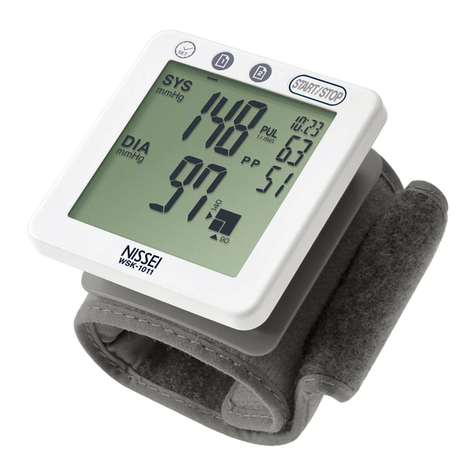
Nissei
Nissei WSK-1011 User manual
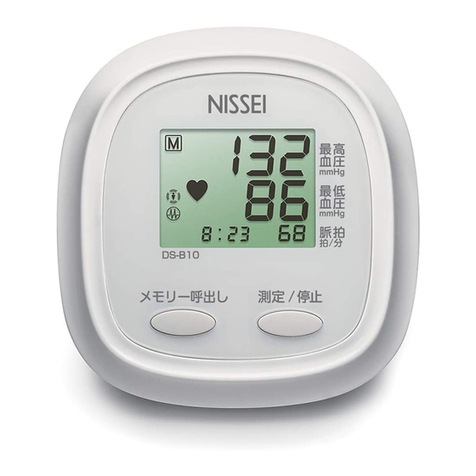
Nissei
Nissei DS-B10 User manual

Nissei
Nissei DS-137 User manual
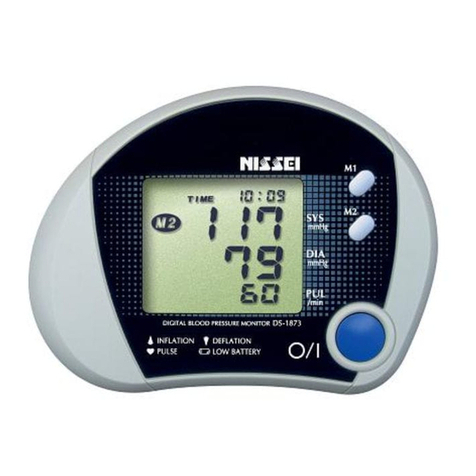
Nissei
Nissei DS-1873 User manual

Nissei
Nissei DSK-1011 User manual

Nissei
Nissei DS-400 User manual
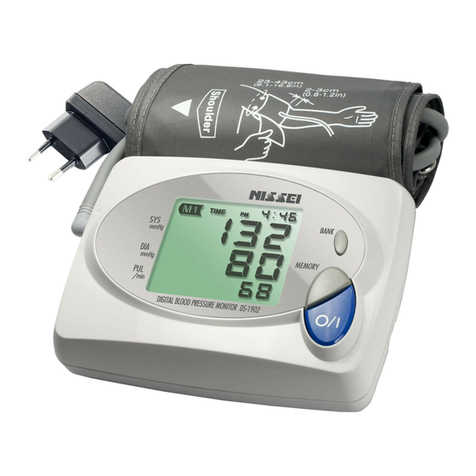
Nissei
Nissei ds-1902 User manual
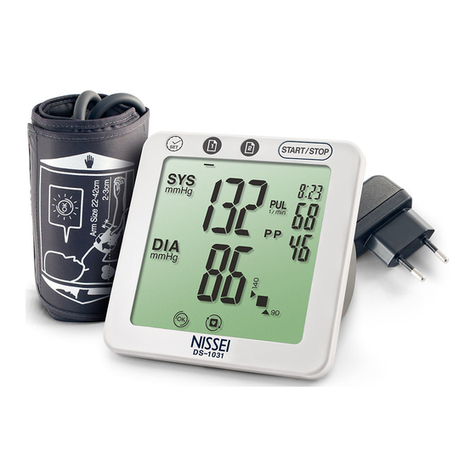
Nissei
Nissei DSK-1031 User manual

Nissei
Nissei WS-820 User manual
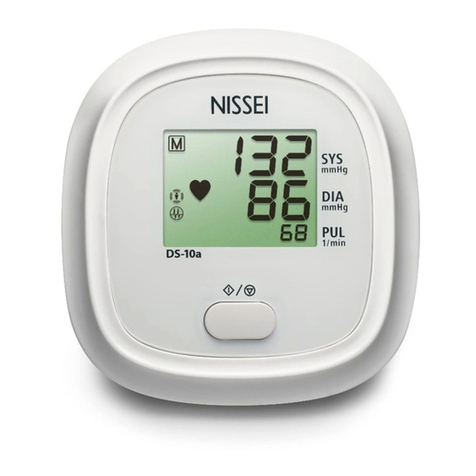
Nissei
Nissei DS-10a User manual
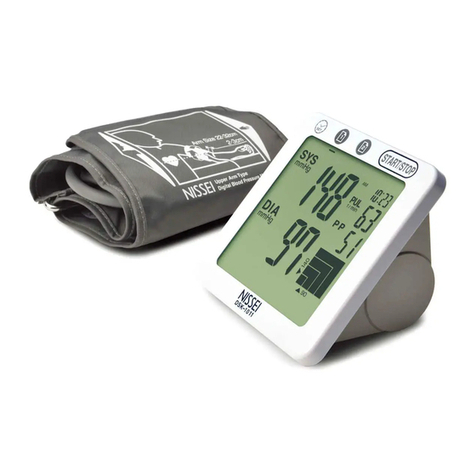
Nissei
Nissei DS-1011 User manual
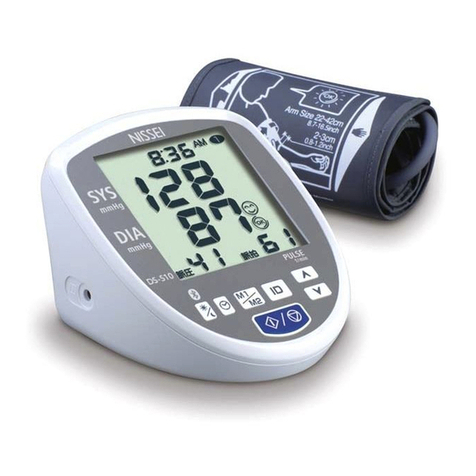
Nissei
Nissei DS-S10 User manual
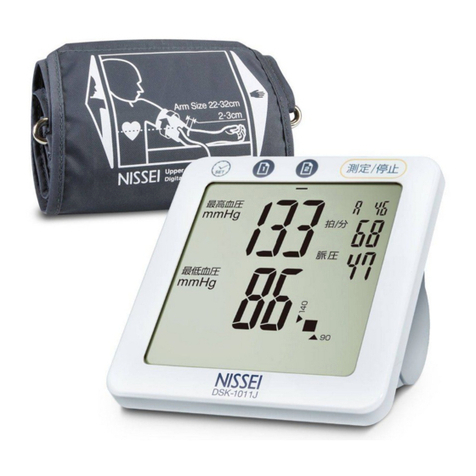
Nissei
Nissei DSK-1011J User manual

Nissei
Nissei DSK-1031 User manual
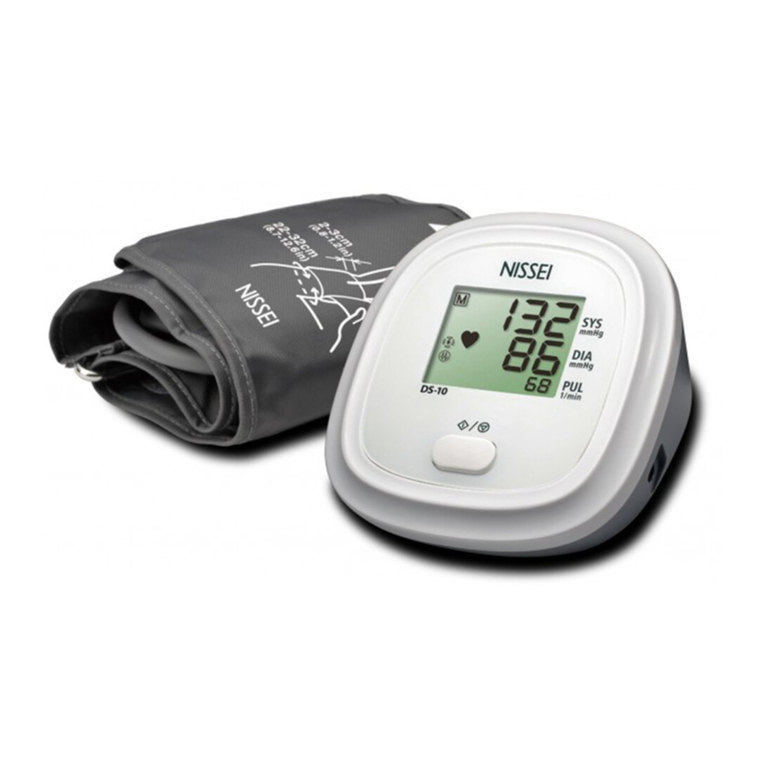
Nissei
Nissei DS-10 User manual



